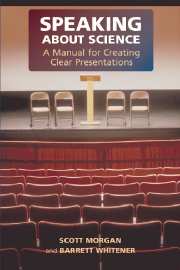Book contents
- Frontmatter
- Contents
- ACKNOWLEDGMENTS
- INTRODUCTION
- 1 THE BASIC PROBLEM WITH ORAL PRESENTATIONS, AND ITS SOLUTION
- 2 THE FIRST STEPS OF PREPARATION
- 3 SELECTING HELPFUL IMAGES
- 4 BEGINNING AND ENDING THE PRESENTATION
- 5 TITLING THE TALK
- AT A GLANCE: THE SEVEN SIGNPOSTS
- AT A GLANCE: 15 KEYS FOR SUCCESS BEHIND THE PODIUM
- 8 THE JOB INTERVIEW
- 9 THE MEDIA INTERVIEW
- 10 MAKING CLEAR POSTERS
- IN CLOSING
- APPENDIX 1 FULL INTRODUCTIONS
- APPENDIX 2 POSTERS
- Index
9 - THE MEDIA INTERVIEW
Published online by Cambridge University Press: 04 August 2010
- Frontmatter
- Contents
- ACKNOWLEDGMENTS
- INTRODUCTION
- 1 THE BASIC PROBLEM WITH ORAL PRESENTATIONS, AND ITS SOLUTION
- 2 THE FIRST STEPS OF PREPARATION
- 3 SELECTING HELPFUL IMAGES
- 4 BEGINNING AND ENDING THE PRESENTATION
- 5 TITLING THE TALK
- AT A GLANCE: THE SEVEN SIGNPOSTS
- AT A GLANCE: 15 KEYS FOR SUCCESS BEHIND THE PODIUM
- 8 THE JOB INTERVIEW
- 9 THE MEDIA INTERVIEW
- 10 MAKING CLEAR POSTERS
- IN CLOSING
- APPENDIX 1 FULL INTRODUCTIONS
- APPENDIX 2 POSTERS
- Index
Summary
We don't do science for the general public. We do it for each other. Good day.
– Renato Dalbecco, the complete text of an interview in The Sciences (1983)At one time, scientists thought they worked in a rather secluded realm. They might continue at their work for years without the outside world paying much attention. But now, magazines, newspapers, and television and radio stations are hungry for scientific news. The most unassuming scientist might suddenly find that his subject matter has become a “hot topic” and that the media is pounding at the door for comments and information. In these instances, the scientist will find his speaking skills immediately displayed to the vast public.
No matter what subject reporters are covering, their questions usually boil down to, “What's new in your field?” and “Why is it important?” They are, in other words, coming with essentially the same questions as an audience does for a talk. Consequently, many of the structural tools used in preparing and delivering a presentation are equally useful in this new context.
At the same time, the media interview is an information exchange like no other. The relatively large audience is one obvious difference between a media presentation and the average talk. Another is that in a media interview, one's words are recorded for all time. The way a speaker's words are interpreted and conveyed to the audience is usually not his decision, but someone else's.
- Type
- Chapter
- Information
- Speaking about ScienceA Manual for Creating Clear Presentations, pp. 93 - 104Publisher: Cambridge University PressPrint publication year: 2006

